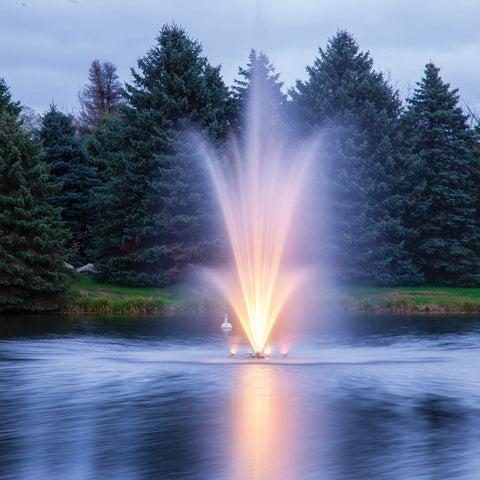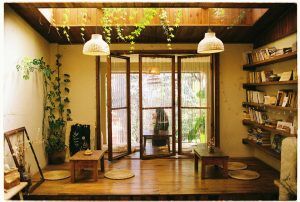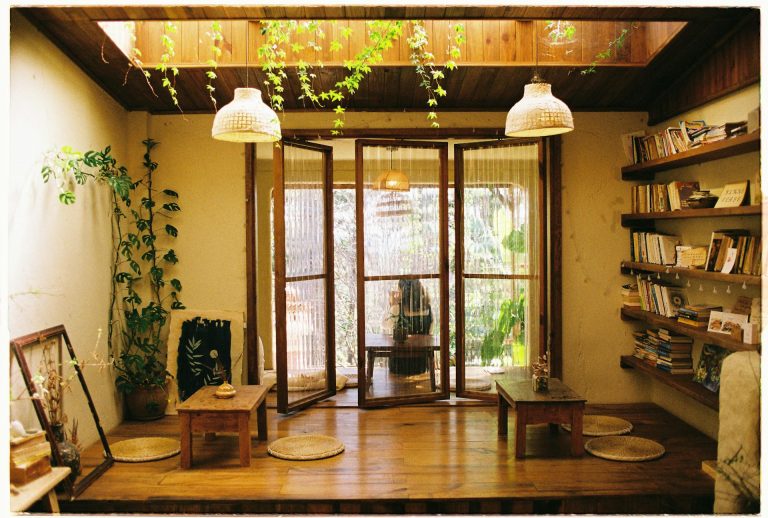While a still, quiet pond offers serene beauty during the day, its presence vanishes entirely the moment the sun dips below the horizon. The solution? Adding pond fountains with lights. This addition instantly transforms that dark, flat surface into a spectacular, moving, and reflective centerpiece that you can enjoy long after dinner.
Far from just a decorative touch, an illuminated fountain also dramatically enhances nighttime aesthetics while offering practical benefits, such as enhanced safety and improved water circulation.
The market is filled with fountain options, but finding the perfect match is crucial. The real key to success is understanding how to accurately match a fountain’s pattern and light strength to your pond’s size, your specific lighting goals, and the demands of your climate. When you get this match right, you secure years of reliable, maintenance-free nighttime beauty and a dazzling, enduring display.
Why a Lighted Pond Fountain Changes How You Use Your Yard
When you add lighting to moving water, you extend how long your outdoor space feels inviting and safe. Research shows that backyard water features provide soothing sounds, wildlife viewing, and scenic beauty, encouraging people to spend more time outdoors.
A well-designed pond fountain with lights can even boost property value. Industry data suggests that landscape lighting projects can deliver strong returns on investment while scoring high for homeowner satisfaction. When your fountain is visible from indoor living areas, it becomes part of your home’s overall curb appeal.
How to Choose Pond Fountains With Lights: Step-by-Step
Choosing the right setup is less about chasing the most dramatic spray and more about getting four things right:
- Pond size and depth
- Spray pattern and visual style
- Lighting technology and color
- Power, energy use, and maintenance
Work through each of these, and you’ll quickly narrow your options.
Start With Pond Size, Depth, And Layout
Before falling in love with photos, measure:
- Surface area (rough length and width)
- Average depth, not just the deepest point
- Shape and layout, including any narrow coves or shelves
Manufacturers typically publish recommended pond sizes for each fountain model. Many homeowners are tempted to oversize the spray relative to the pond, but a jet that is too tall can blow water out of the basin in moderate wind, wasting water and potentially exposing the pump.
Practical sizing tips:
- Look for fountains that list a maximum pond size similar to or slightly above your pond’s surface area
- If your pond is shallow, choose a fountain specified for shallow applications so the pump intake stays submerged and debris is less likely to clog it
- For long, narrow ponds, a single central fountain may not visually cover the entire space. Two smaller lit fountains placed along the length of the pond can look better than one oversized unit
If you are managing a larger pond that also serves as a stormwater or irrigation basin, consider fountains that provide noticeable circulation, which can improve overall water quality and reduce stagnation.
Decide What Kind Of Nighttime Mood You Want
The lighting component of your pond fountain is your primary tool for creating atmosphere after dark. You need to decide on the emotional tone you want your pond to convey. Do you envision a vibrant, energetic display for parties using bright colors, or are you aiming for a soft, romantic glow that highlights the gentle curves of the water for peaceful relaxation?
The color temperature and beam angle of the fountain’s integrated LEDs directly dictate this mood. Cool-toned, bright white lights offer a modern, crisp look, while warmer whites or subtle colors like blue or green lend themselves to a more natural, tranquil, or moody effect. Thinking about the desired mood first ensures your final fountain choice acts as a cohesive piece of your overall landscape design.
Spray Pattern: Bold Showpiece Or Subtle Shimmer?
Common patterns include:
- Geyser or vertical plume for dramatic height and a formal feel
- Tiered patterns that create layered cones of water and catch light beautifully
- Fan or arch patterns that spread lower and wider, better in windy locations
Tall, narrow patterns are clearly visible from a distance and can anchor a large property. Wider, lower patterns feel calmer and often suit smaller backyards where a towering jet would look out of scale.
Light Style: Warm, Cool, Or Color Changing?
Modern fountain lighting is increasingly LED-based, and for good reason. The U.S. Department of Energy reports that residential LED products use at least 75 percent less energy and last up to 25 times longer than incandescent bulbs. That efficiency matters if your fountain runs for several hours every night.
You will usually see three categories:
- Warm white (around 2700–3000K) for a cozy, firelight feel that flatters stone and plantings
- Neutral or cool white for a crisper, more contemporary look that makes water look icy and bright
- RGB or color-changing kits that can shift through colors or lock on a single tone for events
For everyday use, many homeowners choose warm white for the primary look, then use color programs sparingly for parties or holidays so the pond does not feel like a theme park every night.
Plan Power, Controls, And Energy Use
Pond Fountains with LED lights use far less energy than older halogen or incandescent fixtures.
A few planning pointers:
- Use LED lighting kits whenever possible. LEDs can use 75 to 90 percent less energy than incandescent lamps, so you get more light for every watt you pay for
- Put pond fountains and lights on timers or smart plugs. Many households use programmable controls, so the feature turns on at dusk and off at a set time, avoiding wasted runtime after everyone goes to bed
- Check amperage and voltage requirements. Some systems run on low-voltage power through a transformer, which is often safer and simpler to work with around water. Others may use full line voltage and must be installed to code by a qualified electrician
When you run the numbers, the energy cost for efficient LEDs and a modest pump running a few evening hours is typically reasonable, especially with smart timers that prevent all-night operation.
Consider Water Quality, Mosquito Control, And Safety
The aesthetic side of pond fountains with lights is obvious, but the practical benefits matter just as much.
Water Movement And Mosquito Pressure
Stagnant water is a breeding ground for mosquitoes. Guidance from vector control specialists specifically recommends using waterfalls, fountains, or aerators in ponds and ornamental water features to reduce mosquito breeding. A floating fountain that keeps water moving not only looks good but also makes the pond far less attractive to mosquitoes than a still surface.
This does not replace other best practices, such as removing unnecessary standing water elsewhere in the yard, but it is a helpful piece of the puzzle for families who enjoy evenings outdoors.
Nighttime Visibility And Fall Prevention
Extension specialists and lighting researchers point out that landscape lighting enhances safe movement in the garden by illuminating edges and changes in grade. A lit fountain helps define where the water starts, which can reduce the chance that guests, kids, or pets wander too close in low light.
For safety:
- Aim a portion of the beam so it grazes the water’s edge or surrounds, not just the spray
- Avoid placing very bright lights at eye level, where they can cause glare that hides the shoreline
- Keep electrical components, junction boxes, and control panels accessible for inspection and away from areas that flood
Match Your Pond Fountain With Lights To Your Planting And Hardscape
A pond does not exist in isolation. The way you plant and hardscape around it will either highlight or compete with the fountain.
Landscape design experts note that accents, such as water features, help avoid a static, dull composition and should be used thoughtfully so they remain focal points rather than get lost. With that in mind:
- Use simpler plant palettes immediately around the pond so the eye is not pulled in too many directions once the lights come on
- Frame the view from indoors. Many homeowners primarily see their fountain from a kitchen or living room window at night, so arrange paths and plantings with that view in mind
- Combine subtle low-voltage path lighting with the brighter fountain glow so guests can navigate safely without being distracted from the main feature
If your pond is near a patio or deck, consider the sound level too. A very forceful spray pattern can be invigorating in a large landscape, but overwhelming if it’s only a few feet from a seating area where people want to talk.
Maintenance Habits That Protect Your Investment
Even the best-designed pond fountain will disappoint if neglected. Fortunately, most of the important habits are straightforward:
- Clean intake screens and nozzles regularly to remove leaves, algae, and mineral buildup that can throw off spray patterns.
- Inspect cables and connectors at least once a season for damage from rodents, trimmers, or shifting soil.
- Follow winter recommendations for your climate. In cold regions, this might mean removing the fountain until spring; in milder climates, it may simply involve lowering the unit and adjusting runtime.
- Check light lenses for film or scale that can dull the brightness over time, and wipe them gently as needed.
Spreading these checks throughout the year keeps the balance of water and light crisp without turning maintenance into a chore.
Bringing It All Together
A well-chosen pond fountain with lights is less about chasing the most spectacular catalog photo and more about aligning your equipment with the realities of your pond, your energy use, and the way your household spends time outside.
When you consider pond size and depth, desired spray pattern, LED lighting style, power and control options, and basic safety and maintenance, you end up with pond fountains with lights that genuinely extend your living space into the evening, rather than creating new headaches.
For many homeowners, that means more relaxed hours by the water, a more secure and navigable backyard after dark, and an outdoor focal point that feels just as inviting at nine o’clock at night as it does at noon.













